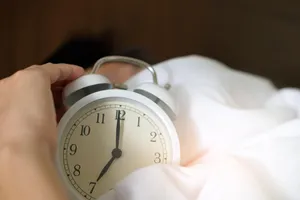Which four sleep phases does sleep consist of?
Theresa Hauser, MSc. | 14.03.2024

Wake Phase, Light Sleep, Deep Sleep, and REM Sleep. The four sleep phases, their significance in the sleep cycle – and how you can wake up better in the morning.
The day is over, off to bed. But what happens then? Until we get up again in the morning, the body recovers during sleep, which it needs for a healthy and efficient life. From the moment we fall asleep, sleep cycle follows sleep cycle. One lasts about 90 to 110 minutes and consists of four sleep phases, which alternate and vary in length. But what function do they have, what do they bring to the body, and what influences them positively and negatively?
What are the four sleep phases?
Experts distinguish four sleep phases that repeat in sleep cycles throughout the night: Wake phases, light sleep, deep sleep, and REM phase or dream sleep phase.
- The first wake phase usually lasts 5 to 10 minutes. It serves as a transition from being awake to sleeping. During this time, heartbeat and breathing begin to slow down, and muscles relax. Short wake phases also occur during the night, but if they last less than 2 minutes, they are not perceived.
- In light sleep, heart rate and breathing slow down compared to the wake phase, body temperature drops, consciousness fades, and brain waves begin to slow down.
- The deep sleep can initially last 20 to 40 minutes and is longer, especially at the beginning of the night. During this time, heartbeat and breathing are at their slowest, brain waves are most slowed, and both body and mind recover the most.
- In the REM phase, which stands for Rapid Eye Movement, particularly rapid eye movements occur – and one dreams very vividly, although dreaming also occurs in other phases. During dream sleep, muscles are in a state of paralysis (except for the eyes and breathing muscles). The first REM sleep per night can be short, but the duration increases with each sleep cycle to up to an hour at a time.
Each of these different sleep phases plays a crucial role in the recovery and regeneration of body and mind. A healthy sleep cycle that includes all four phases is essential for well-being and overall health.
Falling asleep phase: The beginning of the sequence of sleep phases
The falling asleep phase marks the transition from wakefulness to sleep. During this time, the body begins to recover from the day's activities. Muscles begin to relax. Heartbeat and breathing slow down. Thoughts become calmer, contributing to mental recovery and stress reduction.
What negatively affects the falling asleep phase:
- Stress and anxiety: High stress levels and anxiety can make falling asleep difficult by keeping the mind active and awake.
- Electronic devices: Using electronic devices with screens shortly before bedtime can disrupt the sleep cycle due to the mostly stimulating information and blue light exposure.
- Caffeine: Consuming caffeine in the hours before bedtime can negatively affect the falling asleep phase.
What positively affects the falling asleep phase:
- Sleep hygiene: Good sleep habits, such as sleeping regularly at the same times, and a comfortable sleep environment can facilitate the transition into the falling asleep phase.
- Sleep environment: A quiet, dark, and cool sleep environment promotes falling asleep and the transition into deeper sleep phases.
Physical activity: Regular physical activity can improve sleep quality, but intense exercise right before bedtime can make falling asleep difficult.
Light sleep: The underestimated phase within a sleep cycle
Although light sleep is often considered less important than deep sleep and REM sleep, it still has significant functions and contributes greatly to overall recovery. During the light sleep phase, processing of memories and information also takes place. This supports memory and learning. In this phase, body functions such as heartbeat and breathing slow down, helping the body conserve energy and prepare for regeneration.
As people age, they tend to spend more time in light sleep. Certain health conditions or medications can also affect sleep structure and the time spent in light sleep.
Deep sleep: Guardian of health
The deep sleep phases are crucial for physical recovery, growth, and tissue repair, strengthening the immune system, and energy conservation.
Deep sleep regulates metabolism and ensures that your body uses energy efficiently. Specific hormones, those chemical messengers that control various processes in your body, are released in a regulated manner during this phase, keeping body functions in balance. The immune system gets a boost. In this sleep phase, the body effectively fights infections and inflammation. It also facilitates the cleansing of metabolites from the brain, similar to a nightly detoxification, helping to prevent neurodegenerative diseases.
Deep sleep also has special functions that are important for memory. The repeated alternation between REM sleep and deep sleep is said to facilitate the transfer of memories from short-term to long-term memory.
What positively affects deep sleep:
Relaxation and words of relaxation could ensure better deep sleep. This can actually activate the same areas involved in the brain when we are awake and relaxing.
- In a study, words associated with relaxation, such as "calm" or "peace," were played to people during sleep. The result: deep sleep increased.
REM sleep: The important phase of dreams
This is the sleep phase that mainly occurs in the second half of the night, during which you dream intensely. We humans spend about 2 hours in REM sleep with a total sleep duration of 7 hours. Compared to other species, we are in a good middle range.
This phase is crucial for processing emotions, consolidating memories, learning, and cognitive development. In this sleep phase, those arousal patterns that first occurred during learning are reactivated - thereby strengthening memory traces and connections in neural networks. Additionally, REM sleep is characterized by increased activation of the amygdala - a brain region responsible for emotions and processing emotional stimuli.
REM sleep also affects your executive functions and cognitive performance upon waking – and the subjective perception of sleep quality, indicating that longer REM sleep periods contribute to a more restful and satisfying sleep experience.
- A study showed that less awakening and more REM sleep are associated with better performance on cognitive tasks. This connection underscores the importance of REM sleep for cognitive regeneration and its protective role against cognitive decline and the onset of dementia.
The relationship between body temperature and REM sleep duration suggests that thermoregulatory processes during sleep could be an important factor influencing the duration of REM sleep. At lower body temperatures, we tend to have longer REM sleep durations. This suggests that REM sleep, among other things, fulfills important functions related to regulating body and brain temperature.
What has a positive effect
Ensure that your sleep environment is dark, quiet, and cool – a place of comfort for your relaxation, where you feel safe and secure. In REM sleep, muscles are paralyzed, you cannot "flee."
What has a negative effect
- If you have to get up early in the morning, you might miss your last REM phases.
- Some medications also specifically suppress REM sleep.
- Alcohol: Low and moderate doses can shorten the time to fall asleep but disrupt the second half of sleep and significantly increase wake times. The onset of the first dream sleep phase is delayed. With moderate and high doses, the percentage of dream sleep in the entire night decreases significantly.
In general, it is recommended to allow more time for sleep. If the alarm clock wakes you directly from a deep sleep phase in the morning, you are likely to feel more sluggish than if you naturally woke up from light sleep. In any case, your brain needs time in the morning to transition from sleep to wakefulness.
As you transition from sleep to wakefulness, your brain activity gradually shifts to a more alert state, but this can take some time. Environmental factors can influence how quickly you shake off sleep inertia. For example, exposure to noise or light can stimulate the brain and reduce drowsiness. On the other hand, these factors could make things worse if you are already sleep-deprived.





